Here in Niger, having a disability is more than just a physical handicap. It can also be a source of shame and embarrassment. The children that come to our hospital with limbs that are broken or burned, deformed or damaged often bear emotional wounds that have never healed because they have never been treated. Often, these children are hidden away in their home so that nobody can see their disability, and even when they do finally come to the hospital, their disability is usually hidden or covered up. Faces are masked, hands wrapped, and feet covered. It is only at the hospital that they are willing to be uncovered, and some of the children are so accustomed to keeping their disability out of sight that it takes quite a bit of coaxing.
As part of their treatment, many of the children have plaster casts put on their arms and legs. They come out of surgery, and have this white, sterile, itchy cast on their body, and sometimes they have to stay on for quite awhile. Once a cast is put on your arm or leg, there is no hiding it. It may hide a disability, but it draws attention from everyone.
It was only a matter of time before we started painting on these casts during the art therapy sessions. They were so white and boring, and definitely needed some color. At first the children were shocked. “Are you sure we are allowed to do this?” they would ask. But it didn’t take long for them to be convinced, especially since the first few patients that returned to their parents and friends with painted casts were met with cheers and applause! Soon, children couldn’t wait to get their old cast taken off and a new one put on so they could paint it again. Some of the children that were not given a cast felt left out, and we had to come up with creative solutions for them (pipe cleaners, ribbon and colored duct tape wrap around bandages really well).
The cast is meant to hold a foot or hand in place. By keeping it immobilized, healing is allowed to occur. That is an important part of the process, but these children have been immobilized their whole lives. They have been held back and prevented from realizing their true potential. But if the cast represents immobility, painting on the cast is all about movement. It is about moving forward, experimenting and trying something new. It is about new perspectives and new attitudes, and it can help with the healing process as well.
It is amazing to see the transformation that occurs when a cast becomes a canvas. Suddenly, that arm or leg that was hidden away, that limb that was a source of shame is again the center of attention, but this time in a positive way. People stop them in order to look at their cast and pay them compliments. Some parents of patients have even said, “I want them to put a cast on my foot so we can paint it.” Suddenly for the first time children want people to see their arm or leg – what was broken is beautiful, what was damaged is a delight.

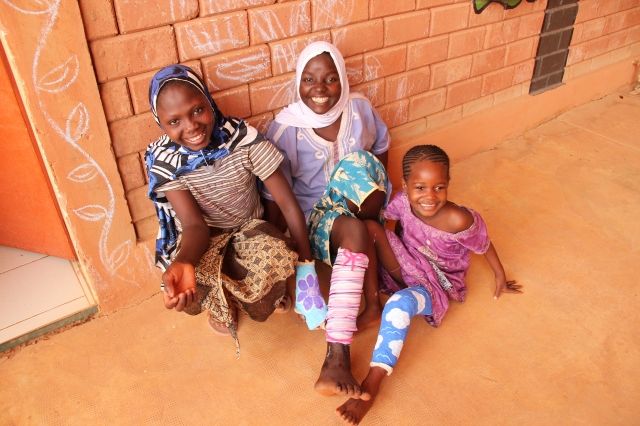







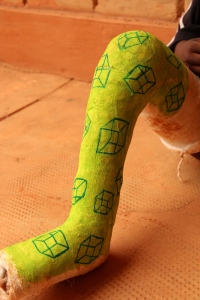


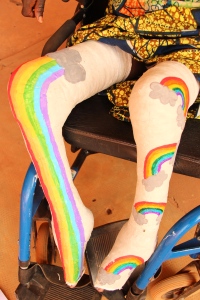





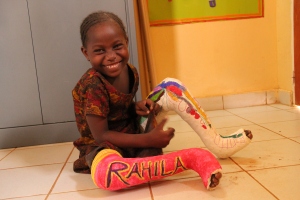
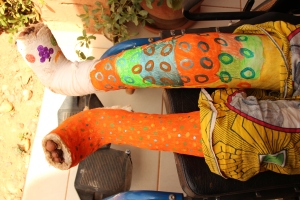
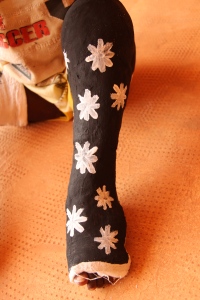

Great job – what little effort to bring great joy! Keep up the good work and continue to bring smiles on faces, some light in a darkened world!
Thank you so much for posting.
Your work will have a lasting effect on all those you have seen and those who are unseen.
LOVE IT! LOVE IT! LOVE IT!
This is very cool what you are doing, making the white cast colorful and fun, being creatively expressed. I keep thinking redemption, redeeming a hard experience and turning it into a good one. It’s like Mary Poppin’s song “Just a spoonful of sugar helps the medicine go down – in a most delightful way!” Julie, have you ever contacted my oldest daughter, Melody? She is COO, Chief Operating Officer, or Director of a non profit, Crutches4Kids, which collects and recycles crutches, walkers, canes from the NYC area and sends them around the world to needy children. Do your patients need some? Mel is on Facebook, Melody Woolford, and there is a separate Crutches4Kids page, also. She has sent some to Tanzania. She needs reliable, trustworthy contacts in countries. Maybe you and she could be part of each others networking? God bless, Sarah Owen
Sent from my iPad
Awesome work Julie!! Keep it up! 🙂
Julie, this post is just delightful and so are you!
Julz – I have tears in my eyes! You are amazing. What you’re doing is amazing. Love you.
I love this!
What an awesome assortment of designs and so neat to see how God takes the broken and turns it into something beautiful!
Miss these smiling faces & am so thankful that you continue to make life colorful & fun. Keep it up! This was definitively one of my Nigerien highlights.